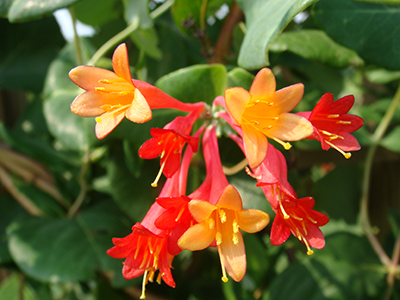Invasive Plants of Particular Concern in Virginia
Non-native exotics such as English ivy (Hedera helix) - shown in the image above - spreads up and strangles a tree. Image by Virginia Witmer. Virginia CZM Program.
Is English Ivy taking over your yard? Learn how to conquer this and other invasiveS.
Invasive plants are introduced, non-native, species that cause health, economic or ecological damage in their new range. Fifty-seven percent of plant species listed as threatened or endangered by the U.S. Fish and Wildlife Service are directly threatened by invasive species. More than 30,000 species of plants have been introduced to the United States since the time of Columbus. Of these, fewer than 3,000 have naturalized and become established in the U.S. landscape outside cultivation. About 1,000 naturalized plant species have become invasive pests that interfere with agriculture, forestry, transportation and utility infrastructure, lawn and garden maintenance, and natural ecosystem processes.
Aggresive, invasive non-natives can quickly spread, cover, and kill native vegetation, such as this invasion of Asian Wisteria, Japanese Honeysuckle and Multiflora Rose. Image by Jan Newton, John Clayton Chapter, VNPS.
Of the 3,200 plant species in Virginia, more than 600, or 18 percent, have been introduced since the founding of Jamestown. The Virginia Department of Conservation and Recreation currently lists 90 species as invasive.
Plant This, Not That!
Regional Native Plant Alternatives to Invasive Species
The Plant Virginia Natives regional campaigns identify invasive plants that are of particular concern in their regions and provide a list of regionally native alternatives.
Click on the links below.
Learn More About Invasive Plants and How You Can Help
Department of Conservation and Recreation, Division of Natural Heritage - Invasive Plants Page (view and download invasive plant factsheets)
Blue Ridge PRISM (Partnership for Regional Invasive Species Management) (view and download invasive plant fact sheets)
VirginiaInvasives.org - learn more about the work of the Virginia Invasive Plant Coalition
Virginia Home Grown Host, Peggy Singlemann, visits Ashburn to talk with Mike Littman about the work of the Loudoun Invasives Removal Alliance to bring area HOA’s together and raise awareness about the environmental and economic threats from invasive plant species.
Serome Hamlin explores the Lower Appomattox River Trail in Petersburg with Elise Neuscheler from Friends of the Lower Appomattox to learn about a volunteer based effort to repair the riparian buffer and restore native wildlife habitat.
In the studio Sean Proietti, Senior Manager of Horticulture and Grounds at Maymont, gives native plant recommendations to replace popular invasive landscape ornamentals.
Amyrose Foll shares tips for removing English ivy from trees.
Shana Williams explains how to keep aggressive growing mint from taking over your garden.
Invasive Plant Control - learn from An Expert
Jim Hurley, Blue Ridge Prism, answers questions about invasive plants and details about herbicide use. Watch on the Plant NOVA Natives YouTube Channel.
Also visit campaign’s invasives webpage for more resources.
Tree-of-heaven is a Significant Threat in Virginia!
Center for Invasive Species and Ecosystem Health
Ailanthus altissima, Tree-of-heaven - pictured above - is furiously aggressive invasive plant. Learn more - Blue Ridge PRISM fact sheet. Tree-of-Heaven is ranked high on the Virginia Invasive Plant List which reflects the significant level of threat it poses to forests and other natural communities and native species.
Plant Invaders of Mid-Atlantic Natural Areas (field guide)
Plant Invaders of Mid-Atlantic Natural Areas, Field Guide is a portable resource for both novice and expert. This practical book is intended for people interested in maintaining or restoring natural areas - from parks and preserves to residential landscapes. Managing invasive plants is crucial if we want our native plants and animals to thrive. Plant Invaders provides information on 92 aquatic and terrestrial invasive species threatening our region, guidance on control methods, discussion of the effects of climate change on invasive plants, explanations and maps of ecoregions and physiographic provinces, and suggestions for native plant alternatives.
Mistaken Identity–Invasive Plants and Their Native Look-Alikes
Native Coral Honeysuckle, Lonicera sempervirens. Photo by Dot Field.
Non-native and invasive Japanese Honeysuckle, Lonicera japonica. Photo by Leslie J. Mehrhoff, University of Connecticut, Bugwood.org









